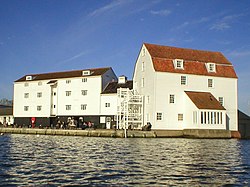This article includes a list of general references, but it lacks sufficient corresponding inline citations .(May 2022) |


Woodbridge Tide Mill in Woodbridge, Suffolk, England is a rare example of a tide mill whose water wheel still turns and is capable of grinding a wholemeal flour.
Contents
The mill is a Grade I listed building. It is a three-storey building constructed from wood; externally it is clad in white Suffolk boarding and has a Gambrel roof. Its machinery reflects the skills and achievements of the early Industrial Revolution. It has been preserved and is open to the public. The reservoir constructed for demonstration purposes is roughly half an acre in extent, the original 7-acre (28,000 m2) one is now a marina.
